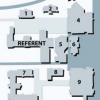Free Online Productivity Tools
i2Speak
i2Symbol
i2OCR
iTex2Img
iWeb2Print
iWeb2Shot
i2Type
iPdf2Split
iPdf2Merge
i2Bopomofo
i2Arabic
i2Style
i2Image
i2PDF
iLatex2Rtf
Sci2ools
ICPR
2006
IEEE
2006
IEEE
Object Localization Based on Directional Information: Case of 2D Raster Data
A directional spatial relationship to a reference object (e.g., "east of the post office") can be represented by a spatial template. The template partitions the space into regions where the relationship holds (to various extents) and regions where it does not hold. The objects for which the relationship holds can then be located. A template can be easily modeled. Computationally, however, exact calculation of the model in case of 2D raster data is prohibitively expensive, and a tractable approximation algorithm was proposed. Here, we introduce a new concept: the concept of the F-template. It leads to a new approximation algorithm, which is faster, gives better results, and is more flexible.
Computer Vision | Directional Spatial Relationship | ICPR 2006 | Spatial Template | Tractable Approximation Algorithm |
| Added | 09 Nov 2009 |
| Updated | 09 Nov 2009 |
| Type | Conference |
| Year | 2006 |
| Where | ICPR |
| Authors | JingBo Ni, Pascal Matsakis, Xin Wang |
Comments (0)

